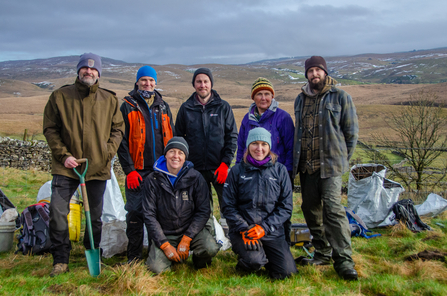
The volunteering and staff Wild Ingleborough tree-planting team - Telling our Story Volunteer, Sara
Bellfields Pasture (c) John Potter

The volunteering and staff Wild Ingleborough tree-planting team - Telling our Story Volunteer, Sara
On a chilly day with patches of snow on the ground, a team of seven intrepid volunteers and two staff gathered at the Selside Outdoor Centre, for a Wild Ingleborough volunteer tree planting task day. After brief introductions, we climbed into two cars and travelled a kilometre or so, to Selside Shaw. This is part of a nationally famous drumlin field which are sediment hills that have been formed by the deposition of glaciers. Drumlins are sometimes referred to as 'basket of eggs' topography because of the rounded bumps that remind people of a box containing eggs!
We parked our vehicles just off the busy Horton in Ribblesdale to Ribblehead road and unloaded the tools and bags containing 1,400 trees. Then it was off on-foot across a very boggy field.
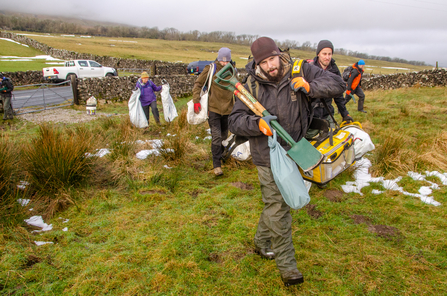
Luckily it was just a short walk carrying all the tools and 1,400 trees to the planting site
- Telling our Story Volunteer, Sara
While some of the Wild Ingleborough tree planting is in the gills high up on the flanks of Ingleborough itself, it was a relief that we were not going far, as the bags soon felt heavy.
Liz Coates, the Wild Ingleborough Project Officer, explained that the Yorkshire Dales landscape lacks trees, with just four percent tree cover within the National Park, of which only a quarter are native, broadleaf species. Ash dieback has had a devastating affect on woodlands within the area. The Wild Ingleborough Project is encouraging natural regeneration of trees in areas where there is a nearby seed source, such as newly acquired YWT reserve Ashes Shaw, which adjoins Colt Park Wood, a fragment of Atlantic Rainforest. They are achieving this by changing the grazing regime from sheep to low-density cattle, and where there is no seed source, the project is planting trees with the aim of creating a seed source for the future.
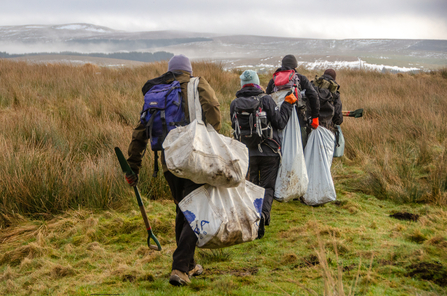
The Wild Ingleborough Project is encouraging natural regeneration of trees in areas where there is a nearby seed source
- Telling our Story Volunteer, Sara
Trees are important for lots of reasons such as providing habitats and food for wildlife, and enhancing our landscapes and providing spaces for recreation - vital for our mental health and physical well-being. Trees also help us meet our net zero climate change targets by absorbing carbon dioxide; producing the oxygen we breathe; purifying our air by absorbing pollutants; conserving soil, and regulating and purifying water.
As the weak sun appeared, the day started to warm up and we were keen to get to work. We stopped to inspect a large barn owl pellet as we climbed over a stile into the first fenced enclosure which was on our plan to be planted.
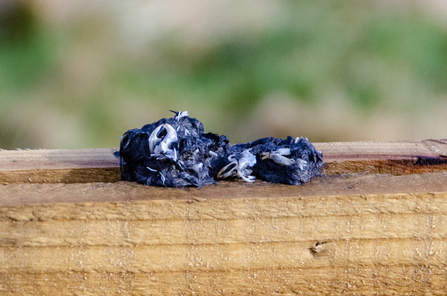
The team spotted an owl pellet on the way to the tree-planting site, pellets are the undigested parts of a bird’s food, such as hair or bones
- Telling our Story Volunteer, Sara
Supplied by the The Woodland Trust, one of Wild Ingleborough’s partners, our trees had been expertly chosen for the soil moisture, pH and the upland location (despite being one of the lowest areas of Wild Ingleborough it is still 290m above sea level). We were planting 0.3ha in two fenced-off corners of the field, backing onto the Settle to Carlilse railway. Liz explained that we were planting in accordance with Network Rail guidelines on what type of trees could be planted near the railway line, avoiding dangers of leaves on the line or even structural damage. The bags of trees we had carried were a mix of oak, bird cherry, spindle, silver and downy birches, alder, blackthorn, purging buckthorn, rowan and hazel.
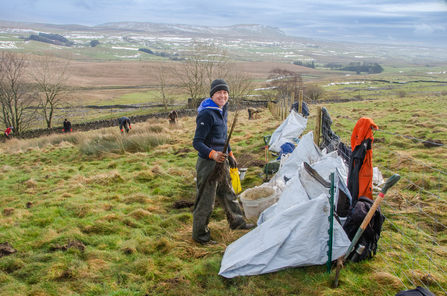
Not a bad day at the office when you have a stunning landscape like this to work in!
- Telling our Story Volunteer, Sara
At Wild Ingleborough they’ve experimented with plastic-free tree guards, though most trees have been planted without guards. Partly as the guards are susceptible to harsh weather in the uplands and also as they believe the trees will grow more bushy and resilient without. They plant at a higher density (double numbers) to compensate for loses due to this harsh environment and browsing from deer and voles. The University of Leeds, one of Wild Ingleborough’s other partners, is monitoring tree planting success rates when using different sorts of protection, including monitoring those trees without any tree guards.
Dwayne Martindale, Wild Ingleborough Project Assistant, demonstrated using a tree planting spade to make a T-shaped hole; then showed us how to gently sweep the roots into the slot, being careful, to ensure all the roots were in the ground. The tree was then planted up to the root collar before firmly tamping the soil down with our heels. As with any expert, he made it look easy!
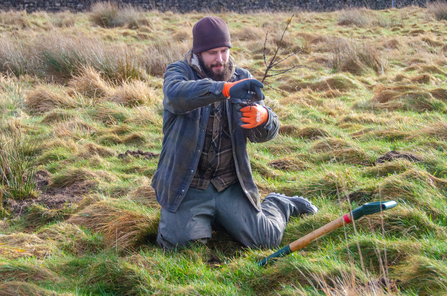
Wild Ingleborough Project Assistant, Dwayne Martindale demonstrating how to plant a tree correctly to avoid damaging the delicate roots
- Telling our Story Volunteer, Sara
I took some more snaps, while everyone else got planting, which you can see in the image gallery below. It was impressive to see the care and speed with which trees were planted. Some of volunteers explained they were regulars with Wild Ingleborough, while others were enjoying a day away from high pressure desk jobs, with tight must-meet deadlines. One volunteer explained that they enjoyed getting outside and protecting the environment. A second commented that we needed trees round here (in the Yorkshire Dales) and they enjoyed doing their part.
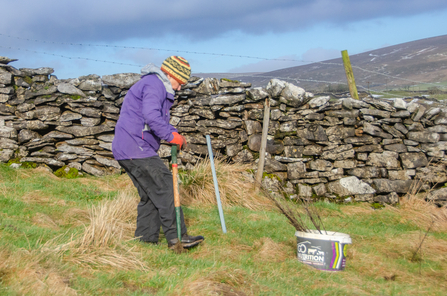
Since the start of the Wild Ingleborugh Project there have been over 104,000 trees planted with the help of a staggering 3000 volunteer hours!
- Telling our Story Volunteer, Sara
Today’s task really demonstrated that many hands really do make light work, or to put it another way, a task is soon accomplished if several people help. The tree-mendous volunteers enable Wild Ingleborough to deliver its challenging aims. To date there have been over 104,000 trees planted with the help of a staggering 3000 volunteer hours. There are opportunities all year round, although March heralds the end of the tree planting season, there are drystone walling and other volunteering tasks to get stuck into. You can find the latest Wild Ingleborough Volunteer Task days in our latest Practical Conservation Calendar which is issued every quarter.
Did you know, Ingleborough and its iconic foothills are the last stronghold for rare and threatened species that are found nowhere else in the world? Right now, we are in a critical race against time to create bigger, better and more connected areas of habitat that give these species the space they need to flourish.
We must protect, restore and reconnect this iconic landscape today before these species are lost forever. Visit here, to find out more about our Wild Ingleborough campaign and what you can do to help protect this unique landscape.